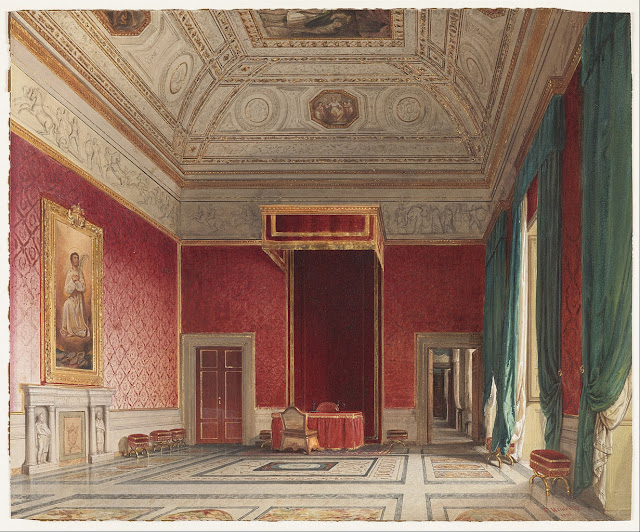 |
| Jan Steen Fantasy Interior with Jan Steen and the family of Gerrit Schouten ca. 1659-60 oil on canvas Nelson-Atkins Museum of Art, Kansas City |
 |
| Johann Atzelt Giants' Hall, Dresden, with Moorish Ballet ca. 1678 engraving Kupferstichkabinett, Dresden |
 |
| Jan van der Heyden Room Corner with Curiosities 1712 oil on canvas Museum of Fine Arts, Budapest |
"There was no visible light inside the room; a soft, celestial glow entered, depending on the need each object had to be more or less perceived; incense burners exhaled delicious perfumes; intertwined ciphers and ornamental motifs hid from the eyes the flames of the lamps that magically illuminated this place of delights. The side where we had come in showed latticed porticoes ornamented with flowers, and before the statue an altar on which shone a flame, and at the base of this altar a cup, crowns of flowers, and garlands; a temple of lighthearted design completed the decor of this side. Opposite was a dark grotto, the god of mystery watching over the entrance, and the floor, covered with a plush carpet, imitated grass. On the ceiling, mythological figures were hanging garlands; and on the side opposite the porticoes was a canopy under which were piles of pillows with a baldachin upheld by cupids."
– from No Tomorrow (Point de landemain) by Vivant Denon, first published in French in 1777, translated by Lydia Davis, 2009
 |
| Jean-François de Troy Le Déjeuner d’huîtres (Luncheon of Oysters) 1735 oil on canvas Musée Condé, Chantilly |
 |
| Jean Charles Delafosse A Masquerade 1770-80 watercolor Cooper Hewitt, Smithsonian Design Museum |
 |
| Hilaire Thierry Salon in Empire taste ca. 1820 watercolor Cooper Hewitt, Smithsonian Design Museum |
 |
| Charlotte Bosanquet Library at Dingestow 1840s watercolor Cooper Hewitt, Smithsonian Design Museum |
 |
| Alexandre Dominique Denuelle View of the Picture Gallery at Château d'Eu 1844 watercolor, gouache Cooper Hewitt, Smithsonian Design Museum |
 |
| Franz Heinrich Sala del Thorvaldsen, Rome 1845 watercolor, gouache Cooper Hewitt, Smithsonian Design Museum |
The careful watercolor (above) depicting Sala del Thorvaldsen, Rome would seem to bear some connection with celebrated Danish artist Bertel Thorvaldsen (1770-1848). He lived in Rome from 1797 to 1838. He was also for many years, while there, the best-known living sculptor in Europe. When Thorvaldsen's workshop in Rome reached its height of productivity about the year 1820 he was employing forty assistant to carry out his intentions and seldom actually carved anything with his own hands. Mark Twain and Czar Alexander I were among his warmest fans. The mere name "Thorvaldsen" in contemporary journalism became a sort of synonym for "Artist." The general trend of these facts encourages the idea that Thorvaldsen himself might in his great Roman days have possessed just such a grandiose audience-chamber as the one in the watercolor. But it is also possible that the space belonged to somebody else entirely and was called after Thorvaldsen simply because it contained some of his work. Curator's notes from Cooper Hewitt do not address the question of the room's ownership or possible use.
 |
| Eduard Gaertner Concert Room of Sans Souci Palace, Potsdam 1852 watercolor, gouache Cooper Hewitt, Smithsonian Design Museum |
 |
| Félix Duban Architectural Fantasy in the style of Pompeii 1856 watercolor Musée d'Orsay, Paris |
 |
| Anton von Werner Quarters of German troops outside Paris, October 1870 1894 oil on canvas Alte Nationalgalerie, Berlin |
 |
| Henry Edward Lamson Library Interior ca. 1900 watercolor, gouache Cooper Hewitt, Smithsonian Design Museum |
 |
| South Kensington Museum Newly-built Ceramics Galleries ca. 1910 gelatin silver photograph Victoria & Albert Museum, London |
 |
| Carl Fredrik Hill Oriental Interior before 1911 pigment on cardboard Malmö Konstmuseum, Sweden |